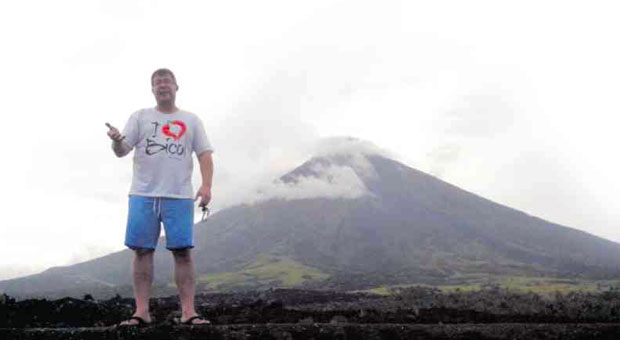
ROMANCING MAYON Ted Litens stands on the helipad on top of hardened lava, dwarfed by Mayon Volcano. The Swede risks life and limb with every visit within the 6-kilometer permanent danger zone in Legazpi City, waiting to see an eruption. SHIENA M. BARRAMEDA
LEGAZPI CITY, Philippines—Pushing forward up unto a heap of volcanic rocks left there by Mayon Volcano’s eruptions in the 1990s and in 2006 and 2009, Swedish seaman Ted Litens scaled the “lava wall” in Legazpi City to take a look—as close as possible—at Mayon’s perfect cone.
It was not his first time to enter Mayon’s 6-kilometer permanent danger zone despite a ban being enforced by authorities since Sept. 15, when they raised alert level 3 due to its heightened unrest and dangers of imminent eruption.
Litens, 44, who works for a European cruise ship, stays in the Philippines two to three months every year. He and his Filipino wife, Marian Hernandez-Litens, 44, a native of Donsol town, Sorsogon province, and their son Bruce, 10, live in a rented apartment in Rawis, Legazpi City.
He calls Legazpi “home” for another special reason—to see Mayon.
“Look at that,” he says with gleam on his face, pointing to the perfect cone of Mayon. “How could you not love that?”
Litens intends to fulfill his longtime wish of seeing a volcanic eruption live, defying prohibitions set by the provincial government of Albay and the Philippine Institute of Volcanology and Seismology (Phivolcs). This has led him to put his life at risk, entering almost daily the 6-km danger zone in Barangay Mabinit in Legazpi, for a front-seat view of the volcano.
The Swede first saw the majestic volcano when he passed by Albay in 2004 on his way to Donsol to snorkel with the whale sharks (butanding). He is a licensed advanced open-water diver with an international firm.
“It was love at first sight,” Litens sighs. It was his first time to see a volcano, something that his homeland Sweden does not have.
“We don’t have disasters like yours in Sweden, only floodings. Our hurricanes are not as strong as your typhoons. I’ve always been interested in nature, its power. You realize how small you really are, you are powerless compared to what nature can do,” he says.
It was also then when he met his wife in Donsol. Their friendship for three years led to marriage in 2008.
“When she took my hand in Manila while she was helping me work for the extension of my visa, I just knew right then that she was a nice girl and that I wanted to marry her,” Litens says.
After their wedding, they bought a piece of land in Donsol, which they converted into a resort while maintaining an apartment in Legazpi.
Litens plans to apply for a Filipino citizenship after his retirement as a seaman and be with his wife in Sorsogon after his son finishes school and finds work. Other than Mayon and his wife, he loves the Philippines for its friendly and helpful people.
“I say Filipinas are good women. They make good, caring wives,” he beams.
Whenever he comes home to Legazpi, Litens never misses a chance to visit Ligñon Hill Nature Park, where the Phivolcs observatory is located, and the lava wall at the foot of Mayon.
“I want to see an eruption. I want to see it live,” Litens says. “I missed the 2006 eruption by a week and the 2009 eruption by a day because I was at work on the ship.”
When he learned that Mayon’s alert level 3 was hoisted, Litens was off from his work on the ship and flew immediately to Legazpi.
His excitement spurred him to discover every possible route to the danger zone, which is not guarded by soldiers deployed by the Philippine Army in Bicol. In Mabinit, he decided to follow the path of the lahar or mudflow from the slopes of the volcano, which usually appears after heavy rains.
Litens says he once planned to climb the volcano but changed his mind after the 2013 phreatic eruption (steam-driven explosion), which killed five tourist mountaineers.
It upset him that the volcano erupted when he was not around, so he won’t be taking any chances this time.
With just a little over a week left in his vacation in late October, Litens hoped to see lava flowing down the volcano soon. “I hope when she erupts it will not be so hazardous because it will affect many lives,” he says.
Despite the danger and his wife’s admonitions, he says he still climbs the lava wall often and sits on the helipad on top. He also takes motorcycle rides on the roads hugging the base of Mayon.
On any given day, Litens takes off from Ligñon Hill on board his motorcycle for the 3-km drive to the edge of the 6-km danger zone. From there, he usually walks another 3 km to reach the lava wall. If the weather is good, he usually drives his motorcycle all the way to the edge of the wall.
“I do not have a death wish. I have a family to take care of. I just want to see (Mayon),” he says.
Litens admits that he does not take any precautions and does not carry protective gear whenever he makes his trips to see Mayon. All he has for an escape plan in case the volcano erupts and he is at the lava wall is to “ride like hell” on his motorcycle.
Now that Mayon is having a prolonged “gestating period,” Litens felt a bit frustrated when he was interviewed by the Inquirer. “I am afraid I might miss the eruption a third time.”
On Oct. 29, Litens was called to report back to work. His ship is cruising somewhere around the Netherlands.
But the romance with Mayon lingers. Litens had promised to return to Albay early December to be with his family again.
“I hope Mayon would wait for me, too.”